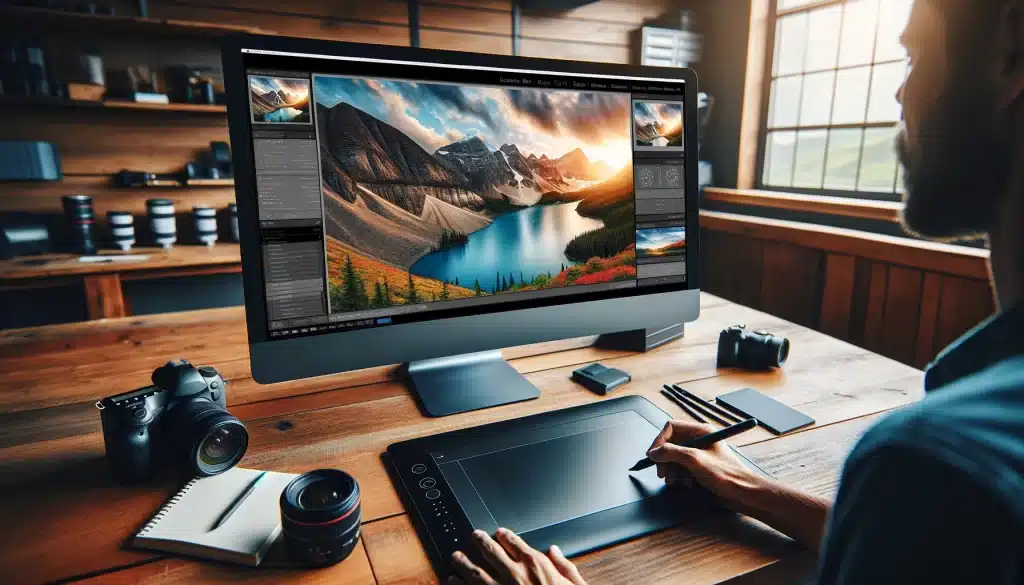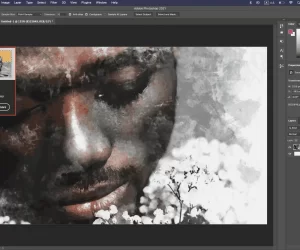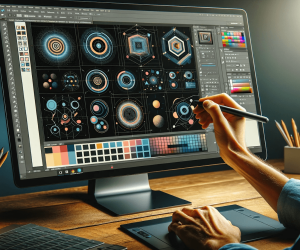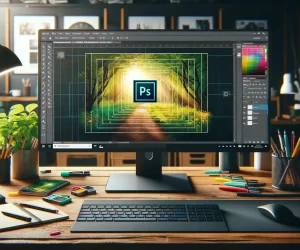
Lightroom Photo Editor – the photo editing software
In the ever-evolving world of digital shooting, the need for efficient and high-powered picture correction options has never been more pressing. Enter Lightroom Photo Editor, a game-changer in the realm of photography. Developed by Adobe, it has transformed the way lensmen, from amateurs to experts, approach the task of correction and organizing their pictures. Lightroom Photo Editor is not just a tool; it’s a complete ecosystem that caters to the needs of today’s lensmen, offering both internet-based flexibility and computer-based depth in its two distinct versions: Lightroom and Lightroom Classic.
Whether you’re looking to enhance your raw images, manage your picture library, or experiment with creative corrections, it offers a suite of characteristics designed to streamline your workflow and elevate your shooting. But what exactly makes it stand out from the myriad of picture correction options available today? Let’s dive into the five key advantages of using it for your photo correction needs.

Table of Contents
5 Advantages of Using Lightroom for Image Correction
Non-Destructive Correction
One of its core strengths is its non-destructive correction capability. This means that your original picture remains untouched, no matter how many adaptations you make. You can experiment with various corrections without the fear of permanently altering your original image. This feature is especially crucial for experts who need to maintain the integrity of their raw files.
Streamlined Workflow
The interface of Lightroom Photo Editor is designed for efficiency. With intuitive controls and easy-to-navigate panels, lensmen can quickly access options and qualities, making the correction process smoother and faster. The solution’s ability to handle batch processing means you can apply corrections to multiple images at once, significantly cutting down your correction time.
Powerful Organizational Options
It isn’t just about correction; it’s also an incredibly powerful tool for organizing your images. With qualities like keyword tagging, ratings, and collections, you can easily categorize and locate pictures within your library. The online storage also allows for easy access to your images across devices, ensuring that your picture library is always at your fingertips.
Advanced Correction Options
It provides a range of advanced correction qualities such as tone curve adjustments, color grading, and detailed sharpening options. These options give lensmen the ability to fine-tune their pictures to achieve the desired look. It also supports RAW file formats, allowing for high-quality corrections on expert-grade picture and video.
Integration with Adobe CC
As part of the Adobe CC suite, it offers seamless integration with other apps. This integration provides a comprehensive correction experience, where lensmen can switch between Lightroom and Photoshop to leverage the strengths of both programs. Whether you need to perform detailed retouching or organize and apply basic corrections, the combined power of these options is unmatched.
It stands out as a top choice for lensmen seeking a balance between high-powered correction capabilities and efficient workflow management. Whether you’re an enthusiast capturing life’s moments or an expert shaping visual stories, it offers the options you need to bring your photographic vision to life.
Versions of Lightroom Photo Editor
In recent years, the software has evolved, branching into two distinct versions to cater to different user needs and workflows. Understanding these types is crucial for lensmen and enthusiasts to choose the right tool for their image correction requirements. Let’s explore what each type offers and how they differ.
Cloud Versatility
Seamless Correction Across Devices with Cloud Integration
- Often referred to as Lightroom CC, it is a cloud image editor.
- It allows users to store and access their pictures anywhere using online storage.
AI Features Enhancing the Correction Experience
- It integrates the AI technology, Adobe Sensei, to offer qualities like automatic tagging and smart organization.
- The AI assists in sorting and finding pictures as per content, making it easier to manage large libraries.
Lightroom Classic: For the Computer Aficionado
In-depth Correction Tools
- The photo editing software is the continuation of the original program, designed for PC use.
- It offers more comprehensive options and features for in-depth picture correction and is preferred by experts for its advanced capabilities.
Optimizing Workflow for Professional Use
- The focus of the software is on providing a robust, feature-rich platform for intensive correction tasks.
- Lightroom Photo Editor offers more control over the correction process and is tailored for photographers who require a high degree of customization and precision in their workflows.

Differences between Lightroom and Lightroom Classic
| Feature | Lightroom | Lightroom Classic |
|---|---|---|
| Primary Focus | Cloud correction and storage | Computer comprehensive correction |
| Storage | Online storage for accessibility across devices | Local storage with optional online syncing |
| Interface | Streamlined, user-friendly interface | More complex, feature-rich interface |
| Workflow | Suited for quick corrections and social media sharing | Ideal for detailed correction and large photo libraries |
| Editing Capabilities | Basic to intermediate correction options | Advanced correction options with more customization |
| File Management | Automatic organization with AI assistance | Manual file organization and management |
| Performance | Fast, efficient correction suitable for lower-end devices | Requires more high-powered hardware for optimal performance |
| Target User | Hobbyists and social media enthusiasts | Expert lensmen and advanced users |
| Offline Access | Limited offline capabilities | Full offline access to files and correction options |
| Pricing | Part of Adobe CC subscription | Available as a standalone subscription or part of Adobe CC |
AI Advancements and Phone Integration with Lightroom Photo Editor
Evolving with AI: Cutting-Edge Technology
It has consistently stayed ahead of the curve, especially with its integration of AI technology. It leverages the AI platform, Adobe Sensei, to offer qualities that are not just about simplifying the correction process but also about enhancing creativity and efficiency. Sensei’s capabilities in the photo editing software range from automatic photo tagging depending on content recognition to advanced correction suggestions tailored to the individual picture.
One of the most notable AI advancements is its ability to analyze and categorize pictures. Sensei can recognize various elements within a photo, such as landscapes, portraits, or even specific objects, and automatically tag them. This high-powered feature transforms how users organize and search through their photo libraries, making it incredibly easy to find the exact picture they need.
Another area where AI has significantly impacted it is in the correction process itself. AI-driven options can now suggest corrections depending on the content of the photo and the style tendencies of the user. These suggestions range from basic adaptations like exposure and contrast to more complex corrections like color grading and selective adaptations.
Phone Integration: Correction on the Go

In today’s fast-paced world, the ability to edit on the go is crucial for many lensmen, and its phone integration meets this need perfectly. With the mobile app, users have the power of substantial photo correction options right at their fingertips, on their iOS or android smartphones, tablets, or iPad.
The app offers a comprehensive set of correction options, mirroring many of the options available on the PC solution. This includes basic adjustments like exposure, correction, cropping, and more advanced qualities like selective edits and presets. The app’s intuitive interface makes it easy for users to apply complex corrections with simple gestures and taps.
One of the key benefits of the phone integration of Lightroom Photo Editor is the synchronization feature. Changes made on a photo in the app are automatically updated across all devices where the user’s Adobe account is logged in. This seamless sync feature ensures that users can start using this photo editing software on their phone and finish on their desktop without any hassle.
Additionally, the software supports RAW correction, allowing lensmen to edit high-quality pictures taken with professional cameras right on their phones. This feature is especially useful for photographers who need to edit and share pictures on the fly, without the need to transfer files to a computer first.
Its advancements in AI technology and its robust mobile integration have significantly enhanced the picture correction experience. These qualities not only make correction more efficient but also open up new creative possibilities, allowing lensmen to achieve professional-level results no matter where they are. It continues to evolve, embracing new technologies to remain at the forefront of digital shooting correction options.
Frequently Asked Questions about Lightroom Photo Editor
Is Lightroom Photo Editor Free?
No, it is not entirely free. Adobe offers a free version, but with limited capabilities. The desktop photo editing software and full mobile app features require a subscription to Adobe CC.
Is Lightroom Free Anymore?
It offers a limited free version. For full functionality, including online storage and advanced correction tools, users need to subscribe to Adobe CC. This subscription also includes updates and new qualities as they are released.
Is Lightroom Better Than Photoshop?
Depends on your needs. It excels in photo organization and batch editing, making it ideal for lensmen. Photoshop offers more advanced image manipulation tools, making it better for graphic design and detailed photo correction.
Is Lightroom Good for Editing Photos?
Yes, it is excellent for photo editing. It provides a range of tools suitable for both amateurs and experts, such as exposure adaptations, hue correction, and presets. Its non-destructive editing environment allows users to experiment without permanently altering the original photo.
Conclusion
As we conclude our exploration of the versatile and powerful solution, it’s essential to reflect on the journey of photo correction and how tools like Lightroom have revolutionized this art. Personally, as a photographer, I’ve experienced its transformative impact in my work. There was a time when using a photo editing software felt like a chore, with cumbersome program and limited capabilities. But with it, things changed dramatically. I remember working on a landscape project where the raw images were good but lacked that punch. It not only streamlined the editing process but also opened up creative avenues that were previously unimaginable. The intuitive controls, coupled with advanced options, allowed me to bring out the true essence of the landscapes, enhancing hues, adjusting lighting, and adding that artistic touch effortlessly.
For those keen on elevating their photography game, it is an indispensable tool. Whether you’re a hobbyist or an expert, the depth and flexibility caters to all levels of expertise. And if you’re looking to master this incredible tool, our comprehensive courses on Lightroom are just what you need. These courses are designed to guide you through every feature, from basic adjustments to advanced techniques, ensuring that you harness its full potential. Join us now and transform your photographic journey.
Read more: Vignetting and the difference between Photoshop and Lightroom »
Have a great lightroom experience!
Read more about Photo Editing with Lightroom and Photoshop:
Course
Get the latest version of Photoshop & Lightroom















